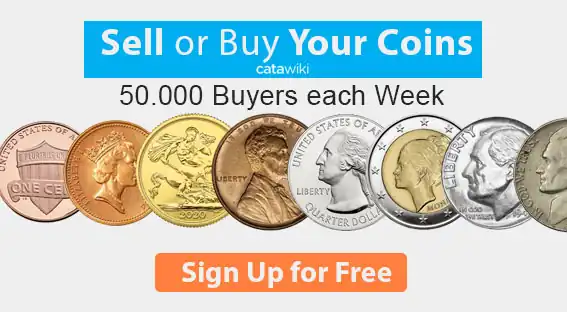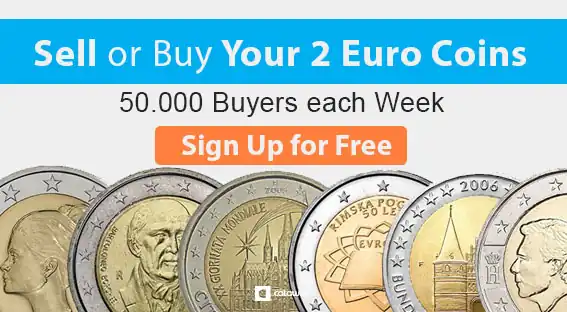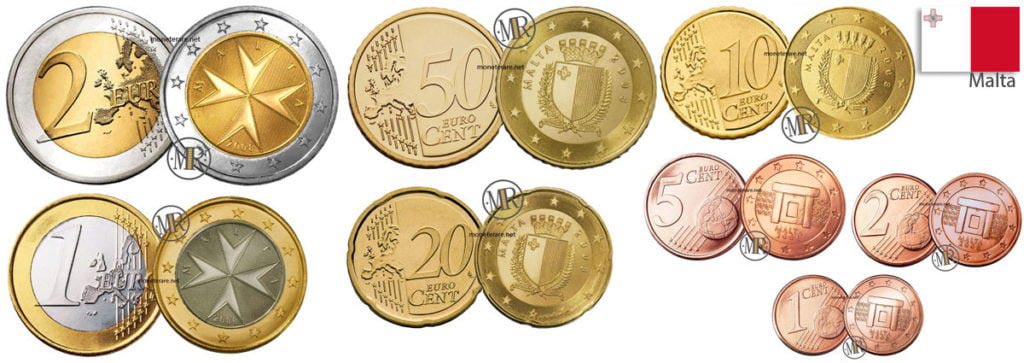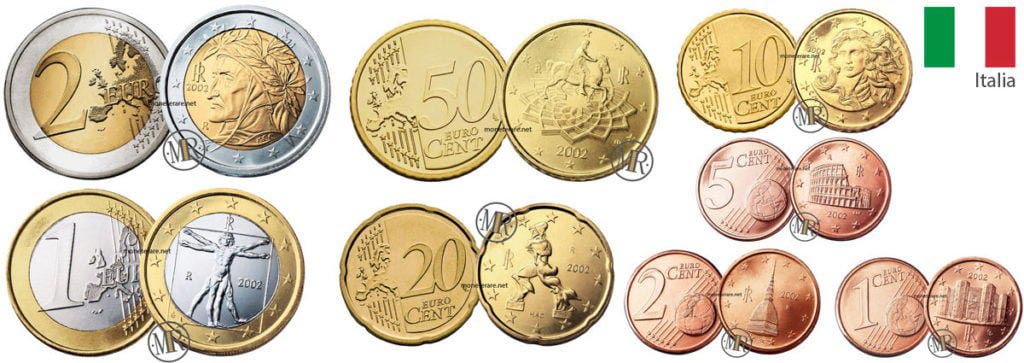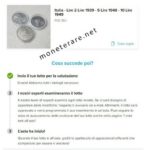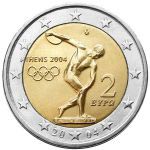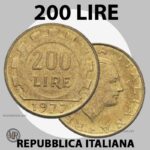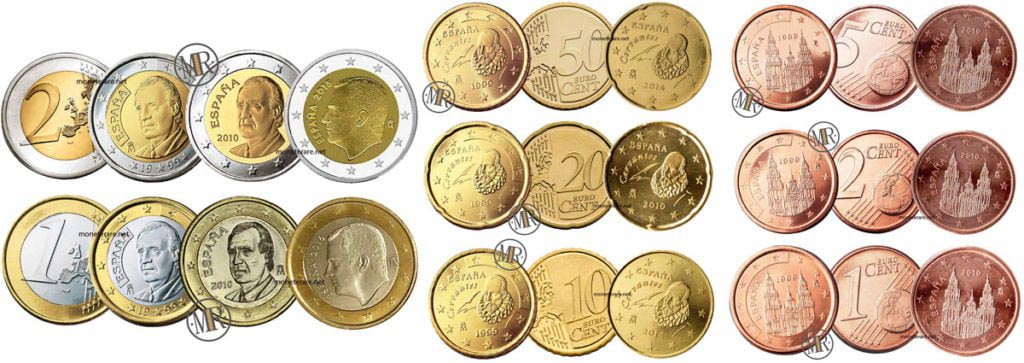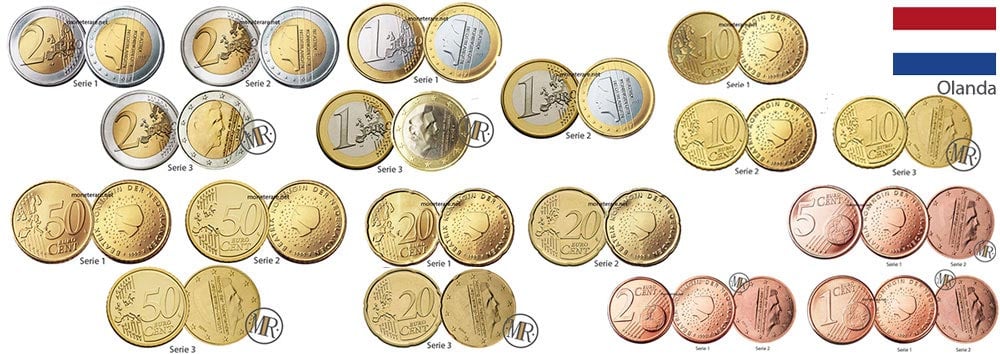
In this page we talk about the Netherlands Euro coins , the characteristics and the quotation of all the denominations of these coins of the Eurocollection.
Brief history of Dutch numismatics
Before moving to the single European currency, the Netherlands used the Dutch Florin as its official currency. This came into force during the 15th century and lasted until the official introduction of the Euro.
The origins of the Dutch florin, however, date back to well before the fifteenth century and precisely to the thirteenth century. At that time the florin was widely used for trade in Europe and beaten in Florence.
It was gradually used locally, from the Netherlands as well as from other countries.
Over time, other coins from the Dutch guilder were created, including the Rijksdaalder with a value of 2,5 florins.
Coming more recently, after the end of the Second World War, because of the serious crisis that the conflict had left, the forint devalued by 30%. This problem was then solved by the implementation of the Marshall Plan.
On January 1, 1999, the Euro officially entered into force with an exchange rate fixed at 1 Euro = 2.20371 Dutch Florins. In particular, from this date on, the forint was still in force for coins and banknotes, while for non-physical payments only the Euro was used.
From January 1, 2002, a double phase of circulation was officially opened, which lasted until February 28, 2002. From this date on, the official currency became the Euro. Until January 1st, 2007 it was still possible to change the coins while for what concerns the banknotes it will be possible to do it until January 1st, 2032.
After this necessary introduction, let’s go together to discover what are the main characteristics and peculiarities of the Netherlands Euro coins.
1 Cent Netherlands Euro Coins
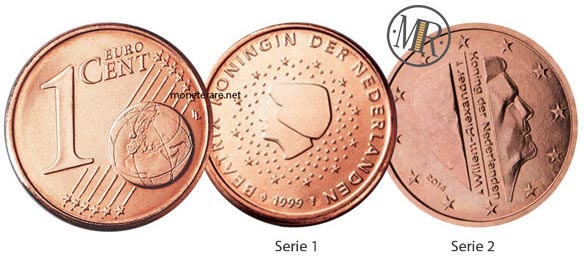
The first coin that we will analyse is, of course, the 1 cent Netherlands Euro Coins that opens the collection. The author for the first series of the coin is Bruno Ninaber van Eyben while for the second series is Erwin Olaf.
It is important to note that there are two versions for this and the other Dutch euro coins. One refers to the period from 1999 to 2013 and the second refers to the years from 2014 onwards.
As far as the first obverse version is concerned, it presents the depiction of the face of the Queen of Holland Beatrix turned to the left. It is surrounded by dots in relief in which the 12 five-pointed stars representing the European states are well inserted.
On the outside there is the inscription BEATRIX KONINGIN DER NEDERLANDEN. Below is the thousandth of a coin followed on the right by the winged caduceus symbol of the Mint and on the left by the variable symbol of the Mint Director.
In the second version of 2014, William Alexander, the current King of the Netherlands and son of Queen Beatrix, who ascended the throne after his abdication, is depicted.
The King’s face faces to the right and is cut in two by two vertical lines.
The variable symbol of the Mint Director, the inscription Willem-Alexander and the symbol of the Mint of Utrecht appear in one.
In the other, instead, the inscription KONING DER NEDERLANDEN and the thousandth of minting. On the outermost edge the 12 stars symbol of the countries of the European Union.
On the reverse side, both coins are identical to the other European coins.
But let’s move on to the technical specifications.
Technical specifications of the Dutch 1-cent coin
- Materials : Copper-plated steel (steel 94.35%, copper 5.65%)
- Thickness: The thickness is 1.67 mm
- Weight: Weight is equal to 2.30 g
- Diameter: The diameter is 16.25 mm
- Outline: Completely smooth
- Engraver: Bruno Ninaber van Eyben – Erwin Olaf
Value and circulation of the 1 Cent Euro Netherlands Coins
2 Cents Netherlands Euro Coins
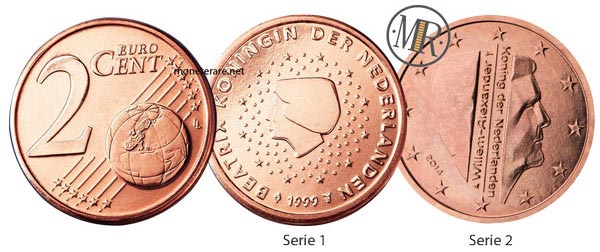
Let us now move on to the next currency, the 2 cent euro Netherlands coin. Also in this case the author is Bruno Ninaber van Eyben for the first and Erwin Olaf for the second.
As for the first version (1999 – 2013), the straight coin represents the face of the Queen of Holland Beatrix facing left. The bust is surrounded by several dots in relief and 12 stars representing the European states.
All around in bold letters BEATRIX KONINGIN DER NEDERLANDEN. I lowered the thousandth of a coin with the symbol of the Mint of Utrecht on the right and the variable symbol of the Mint Director on the left.
The second version of 2014 instead depicts in the obverse the King of Holland William Alexander who ascended the throne after the deposition of his mother Beatrice. In particular, the bust is facing right and is interrupted in the center by a line.
To the left of the line are engraved the symbol of the Mint of Utrecht, the inscription Willem-Alexander and the variable symbol of the Mint Director. To the right of the line is the word KONING DER NEDERLANDEN.
At the bottom left of the effigy is the thousandth of a coinage.
On the reverse side, the two coins are identical to all other 2-cent European coins.
Let’s see the technical specifications.
Technical specifications of the Dutch 2-cent coin
- Materials: Copper-plated steel (steel 94.35%, copper 5.65%)
- Thickness: The thickness is equal 1.67 mm
- Weight: Weight increases to 3.06 g
- Diameter: Same for the diameter which is 18.25 mm
- Outline: Incused horizontal thread
- Engraver: Bruno Ninaber van Eyben – Erwin Olaf
Value and circulation of the 2 Cents Euro Netherlands Coins
5 Cents Netherlands Euro Coins
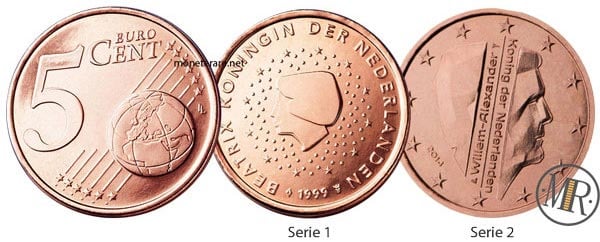
We have now reached the third currency in the Dutch euro collection, the 5-cent coin from the Netherlands. The author for the first version of the coin is Bruno Ninaber van Eyben and for the second version is Erwin Olaf.
As for the first version, the edition dating back to the years 1999-2013, in the obverse the coin represents the Queen Beatrix facing left. The Queen’s face is surrounded by dots in relief in which are cleverly inserted the 12 five-pointed stars representing the states of the European Union.
The face is surrounded by the words BEATRIX KONINGIN DER NEDERLANDEN. At the bottom is the thousandth coinage with the winged caduceus symbol of the Mint of Utrecht on the right and the variable symbol of the Mint Director on the left.
As far as the second version of the coin is concerned, the one produced from 2014 onwards, on the obverse is represented the son of Beatrice, the King of Holland Guglielmo Alessandro with the face this time facing right.
In particular, the effigy is cut in half by a line. On the left is the inscription Willem-Alexander and the two symbols of the Mint of Utrecht and the variable one of the Mint Director. On the right is the inscription KONING DER NEDERLANDEN.
The whole is surrounded by 12 five-pointed stars, symbol of the countries of the European Union, and at the bottom left is the thousandth of a coinage.
As far as the Verso is concerned, both currencies are identical to the other European Union coins.
But let’s move on immediately to the technical specifications.
Technical specifications of the Dutch 5-cent coin
- Materials: Steel plated with copper (steel is present for 94.35% copper for 5.65%)
- Thickness: The thickness is always 1.67 mm
- Weight: Weight increases even further to 3.90 g
- Diameter: The diameter is 21.25 mm
- Outline: Completely smooth
- Engraver: Bruno Ninaber van Eyben – Erwin Olaf
Value and circulation of the 5 Cents Euro Netherlands Coins
10 Cents Netherlands Euro Coins
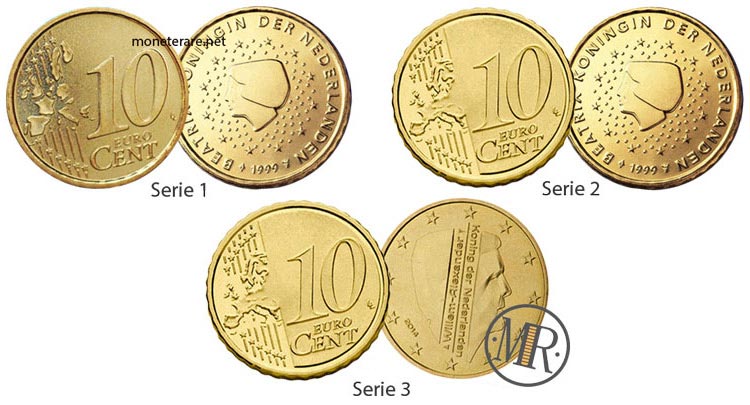
We arrived at the 10 cent Netherlands Euro coin. Also in this case the author is Bruno Ninaber van Eyben for the first and second version of the coin and Erwin Olaf for the third.
The first and second versions (1999-2013) represent on the Obverse the effigy of the Queen of Holland Beatrix facing left. Her face is surrounded by dots in relief accompanied by the 12 five-pointed stars representing the European states.
The whole is followed all around by the inscription BEATRIX KONINGIN DER NEDERLANDEN with the year of minting at the bottom, on the right the symbol of the Mint of Utrecht and on the left the variable symbol of the Mint Director.
As for the third version of 2014 onwards, the subject represented in the obverse part of the coin is the King of Holland William Alexander, who succeeded his mother Beatrice in 2013. In particular, the effigy is facing right and the whole face is cut by a vertical line.
To the left of the line is the inscription Willem-Alexander accompanied by the symbol of the Mint of Utrecht and the variable symbol of the Mint Director.
To the right of the line is the word KONING DER NEDERLANDEN. At the bottom left there is the thousandth of minting and the whole is naturally surrounded by the 12 stars that symbolize the European Union.
Reverse side of 10 Cents Netherlands Euro Coins
As far as the reverse is concerned, it should be said that the first version has a map of the European countries drawn with the states separated from each other, instead from 2007 onwards it uses the drawing with all the countries of the Euro Zone united with each other. Therefore the second and third series of the coin present the same modified reverse.
Let’s see together the characteristics of this coin.
Technical specifications of the Dutch 10 cent coin
- Materials: Nordic Gold (copper 89% – aluminium 5% – zinc 5% – tin 1%)
- Thickness: Thickness increases to 1.93 mm
- Weight: The weight also increases to reach 4.10 g
- Diameter: The diameter decreases to 19.75 mm.
- Outline: Rowed with thick knurling
- Engraver: Bruno Ninaber van Eyben – Erwin Olaf
Value and circulation of the 10 Cents Euro Netherlands Coins
20 Cents Netherlands Euro Coins
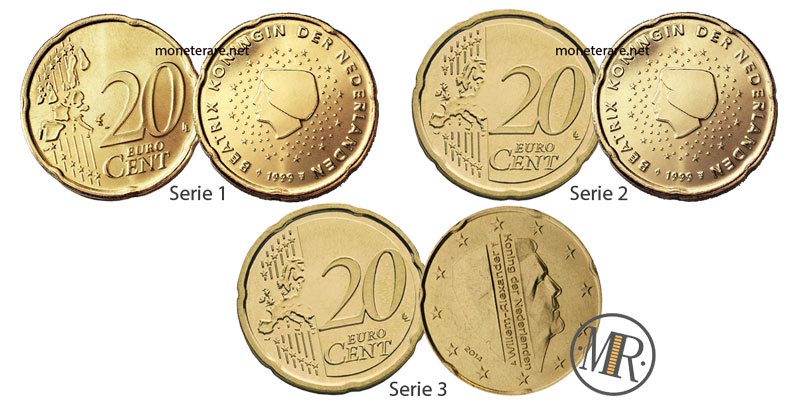
The next denomination to be dealt with are the 20 cent Netherlands Euro Coins. Bruno Ninaber van Eyben is the author for the first and second coin while for the third is Erwin Olaf.
The first and second versions, coined between 1999 and 2013, present the face of the Queen of Holland Beatrix facing to the left in a straight line. The effigy is surrounded by dots in relief and 12 five-pointed stars representing the countries of the European Union.
All around there is in bold the writing BEATRIX KONINGIN DER NEDERLANDEN. At the bottom of the centre is the thousandth mint followed on the right by the winged caduceus symbol of the Mint of Utrecht and on the left by the variable symbol of the Mint Director.
The other coin, the third version of 2014, represents the face of the son of Queen Beatrix, King William Alexander of Holland. This one faces right and the effigy is cut in two by a line.
On the left of this line there is the inscription Willem-Alexander followed by the symbol of the Mint of Utrecht and the variable symbol of the Mint Director. On the right is the inscription KONING DER NEDERLANDEN.
The entire coin is surrounded by 12 five-pointed stars and the thousandth of a coin is shown below.
The verse of the first version has a map of the European countries with the states all separated from each other. From 2007 onwards, a version with the Eurozone countries united is used. For this reason, the second and third series of this currency have the same modified reverse.
Let’s see its technical specifications together.
Technical specifications of the Dutch 20 cent coin
- Materials: Also in this case the material is Nordic Gold (copper 89% – aluminium 5% – zinc 5% – tin 1%)
- Thickness: Thickness increases to 2.14 mm
- Weight: Weight starts to become important when you get to 5.74 g
- Diameter: The diameter increases to 22.25 mm
- Outline: The contour is a wide knurling
- Engraver: Bruno Ninaber van Eyben – Erwin Olaf
Value and circulation of the 20 Cents Euro Netherlands Coins
50 Cents Netherlands Euro Coins
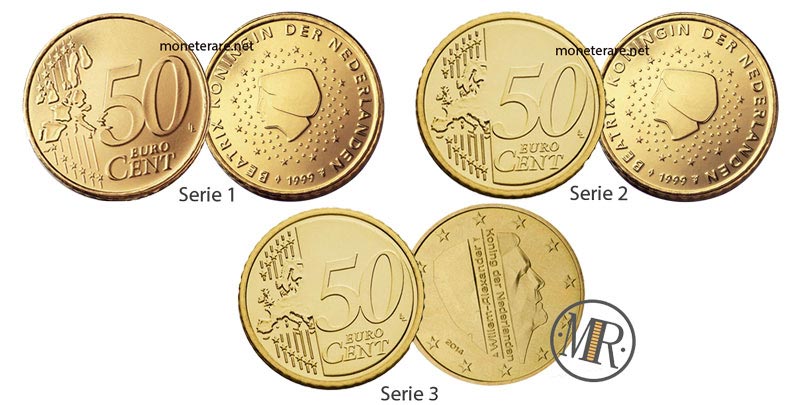
So let’s get to the 50 cents Netherlands Euro Coins. The author for the first and second coin is Bruno Ninaber van Eyben while for the third is Erwin Olaf.
Let’s start with the first and second versions, i.e. those dating back to the years 1999 to 2013. These coins represent the effigy of Queen Beatrix facing left on the obverse. Around the face there are dots in relief between which are also cleverly placed the 12 five-pointed stars that symbolize the European states.
On the outermost edge is the inscription BEATRIX KONINGIN DER NEDERLANDEN, while at the bottom the thousandth coin followed on the left by the symbol of the Mint of Utrecht and on the right by the variable symbol of the Mint Director.
As for the third version, the one valid from 2014 onwards, this represents King William Alexander son of Beatrice and King of Holland from 2013.
In particular, its effigy is turned to the right and is cut in two by a line.
To the left of the line is the inscription Willem-Alexander followed by the winged caduceus symbol of the Utrecht Mint and the variable symbol of the Mint Director. On the right hand side of the line, only the inscription: KONING DER NEDERLANDEN is engraved.
At the bottom left is the thousandth of a coin minted and the entire coin is surrounded by 12 five-pointed stars.
The first version uses the Towards the map of Eurozone states with all countries separated from each other. Since 2007, however, the image has been modified and it was decided to depict the Eurozone countries united. In fact, the second and third series of the coin present this new version.
Let’s see now the technical specifications.
Technical specifications of the Dutch 50 cent coin
- Materials: Once again the material is the Nordic Gold characterized by: 89% copper – 5% aluminum – 5% zinc – 5% tin – 1%,
- Thickness: The thickness increases even more to reach 2.38 mm
- Weight: Weight also continues to rise to 7.80 g
- Diameter: The diameter increases slightly to 24.25 mm
- Outline: The contour is grooved with thick knurling
- Engraver: Bruno Ninaber van Eyben – Erwin Olaf
Value and circulation of the 50 Cents Euro Netherlands Coins
The value of the Dutch 50 cents euro coins has become interesting since 2003, when on average twice the face value is quoted. The most quoted is the 2018 Dutch 50-cent coin, which is worth five times its face value.
1 Euro Dutch Coins
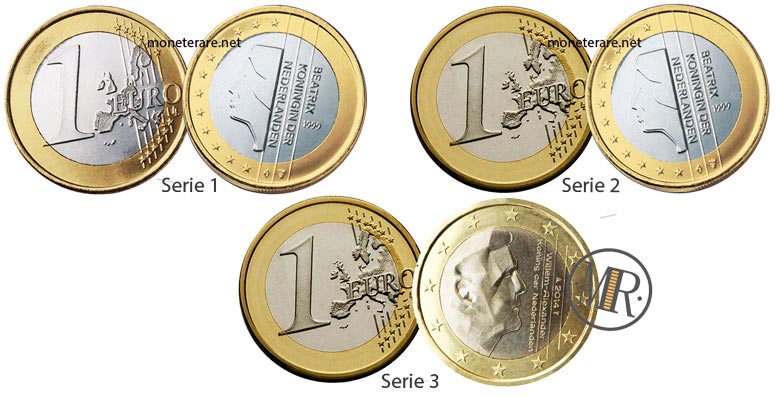
Here we are with the next denomination that is the 1 Euro Dutch coin. The author for the first and the second coin is Bruno Ninaber van Eyben while for the third is Erwin Olaf.
The first two versions from 1999 to 2013 change a bit compared to the coins of the other denominations. As you see the face shown is always that of the Queen of Holland Beatrix facing left. To the right of the face there are three vertical lines inside which is inserted the inscription BEATRIX KONINGIN DER NEDERLANDEN arranged on all three levels.
Below are the thousandth mint, the symbol of the Utrecht Mint and the variable symbol of the Mint’s director.
To the left of the face are engraved the 12 five-pointed stars, symbol of the States of the European Union.
As for the third version of the coin, valid from 2014 onwards, also in this case we notice some changes compared to the design used for the other denominations. The effigy is always that of King William Alexander son of Queen Beatrix and King of Holland from 2013.
The face is facing right and is followed, always on the right, by three lines. In the spaces between the various lines are engraved respectively from the right: the thousandth of minting inserted between the symbol of the Mint of Utrecht and the variable symbol of the Mint Director, the words Willem-Alexander and in the leftmost part the words KONING DER NEDERLANDEN.
The entire coin is then surrounded by the usual 12 five-pointed stars.
Reverse side of 1 Euro Netherlands Coins
The reverse of the one euro coin changes in 2007 for all countries of the Euro Zone. In fact, the common side until 2007 used the map of the states belonging to the Eurozone with the countries marked by the borders. Since 2007, this image has been modified with a more unified version that makes the borders between the countries of the Euro Zone disappear. In fact, the second and third series of the coin use this new version.
Technical specifications of the Dutch 1 euro coins
- Materials: Bimetallic. Outer part: nickel-brass (copper 75% – zinc 20% – nickel 5%); inner part: copper-nickel (copper 75% – nickel 25%).
- Thickness: The thickness decreases slightly to 2.33 mm
- Weight: Even the weight decreases slightly to 7.50 g
- Diameter: Same for the diameter measuring 23.25 mm
- Outline: The contour is striped discontinuously
- Engraver: Bruno Ninaber van Eyben – Erwin Olaf
Value and circulation of the 1 Euro Netherlands Coins
The Dutch 1 euro coins in the first series do not have higher values than their face value until the year of issue 2003. In fact, both the 1 euro coin Netherlands 2000 and 1 euro Netherlands 2001 have a value of 2 euros, being very common.
Among the Dutch 1 euro coins in the third series, the value of the euro in 2018 stands out, which is twice as high as its face value.
2 Euro Dutch Coins
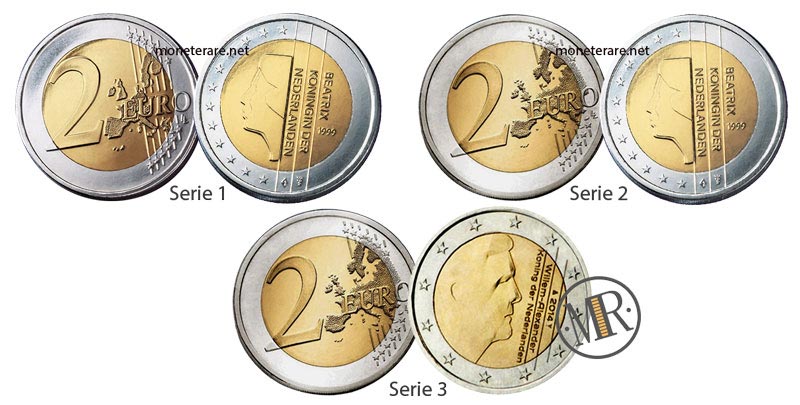
Here we are with the last coin of this collection, the 2 Euro coin from the Netherlands. As for the others, the first and second edition was engraved by Bruno Ninaber van Eyben and the third by Erwin Olaf. Keep in mind that there are many other dutch commemorative euro coins, and you can check them out here: netherlands 2 euro coins.
As regards the first and second series (1999-2013), the coin shows the representation of Queen Beatrix facing to the left at the Straight. To the right of the coin there are three lines with the inscription BEATRIX KONINGIN DER NEDERLANDEN on three levels.
Below right the thousandth of mintage and even lower the winged caduceus symbol of the Mint of Utrecht and the variable symbol of the Mint Director. On the left, arranged in a semicircle, there are the 12 five-pointed stars, symbol of the States of the European Union.
Always on the right there are three lines which form three levels. Starting from the left, the following are depicted respectively: the inscription KONING DER NEDERLANDEN, the inscription Willem-Alexander and the thousandth of coinage inserted between the winged caduceus symbol of the Mint of Utrecht and the variable symbol of the Mint Director.
All this is surrounded by the 12 stars that represent the European states.
Reverse side of 2 Euro Netherlands Coins
The Reverse of the coin, as for the 1 Euro coin, changes in 2007 for all the countries of the Eurozone. Until 2007, the common side used the map of the Eurozone countries with the countries separated by borders. Since 2007 the map has been modified in favour of a more unitary version that represents the Eurozone States without borders between them. The second and third series of the coin use this second version of the map.
As for the third version of the coin in force from 2014 onwards, the effigy of King William Alexander who ascended the throne after the abdication of his mother Beatrix in 2013 is depicted on the obverse. Specifically, the face is facing right.
Let’s see also the technical specifications.
Technical specifications of the Dutch 2 euro coins
- Materials: Also in this case the material is different between the outside and the inside. The external part is characterized by nickel-brass (copper 75% – zinc 20% – nickel 5%); the internal part is instead in copper-nickel (copper 75% – nickel 25%).
- Thickness: The thickness decreases slightly to 2.20 mm
- Weight: The weight increases significantly to 8.50 g.
- Diameter: The diameter also increases to 25.75 mm
- Outline: The contour is finely knurled with the inscription GOD; ZIJ; MET; ONS (which means “God be with us”) interspersed with 4 stars
- Engraver: Bruno Ninaber van Eyben – Erwin Olaf
Value and circulation of the 2 Euro Netherlands Coins
As far as the Dutch 2 euro coins of the first series are concerned, there are no interesting pieces until the 2003 series. The 2003, 2004 and 2005 coins are all quoted at the same price level.
Value of 2 Netherlands Euro Coins of years 1999, 2000, 2001, 2002
The 2 euro Netherlands 1999 has no significant value, as do the 2 euro Netherlands 2000, 2001, 2002.
With regard to the second series, the most valuable currency is the 2 Dutch euros of 2010, which are quoted more than twice their face value.
Of the latest series, however, the most interesting and listed piece is that of the rare 2 euro Dutch of 2019 which is worth over 15 euro and that one of year 2018 also.
Value 2 euro Netherlands year 2014
Bad news if you were thinking that the 2 euro Netherlands 2014 could be worth a lot. It is a common coin that is only worth its face value, which is 2 euro indeed.
Want to see more coins from the Euro collection?
- Two pages you can’t miss: 2 Euro Commemorative Coins and Rare Euro Coins
- The precious Vatican euro coins can be seen here and also the San Marino euro coins
- Here you can see the Malta euro coins and here the Cyprus euro coins.
- Euro coins from Germany can be found here and Euro coins from Estonia and Latvia Euro Coins here.
- Euro coins from France can be found here, as well as Euro coins from Austria.
- Also of great interest are the euro coins from Greece and the euro coins of Luxembourg.
- Here you will find Lithuania Euro coins and Andorra Euro coins
- We also talked about Slovenian Euro coins and Slovakia Euro coins.
- Check also Spanish Euro Coins here and Euro Coins of Portugal here.
- The Netherlands euro coins can be found here and the Ireland euro coins here.
- All precious Monaco Euro coins are here and Belgium Euro coins here
